Every year, thousands of older adults end up in emergency rooms because they took two pills that did the same thing-without knowing it. It’s not a mistake you can afford to make. If you or a loved one sees multiple specialists, takes several medications, or uses over-the-counter supplements, you’re at risk for duplicate medications. This isn’t just about taking too many pills. It’s about taking pills that overlap in effect, which can lead to dizziness, falls, kidney damage, internal bleeding, or even death.
Why Duplicate Medications Happen
Specialists focus on one part of your health. A cardiologist treats your heart. An endocrinologist handles your diabetes. A neurologist manages your Parkinson’s. But none of them see the full picture. Your primary care doctor might have prescribed metoprolol for high blood pressure. Then your cardiologist, unaware of that, prescribes another beta-blocker-say, atenolol. Now you’re getting double the dose of the same drug class. Your blood pressure drops too low. You feel faint. You fall. That’s not rare. It happens every day.According to a 2015 study in the Journal of the American Medical Informatics Association, pharmacies saw 20.4 duplicate medication alerts for every 100 prescriptions filled. In 17% of those cases, there was a real risk of harm. And here’s the scary part: pharmacists had to step in to fix the problem in 32% of those alerts. That means nearly one in three times, a dangerous overlap slipped through without intervention.
It gets worse when patients use multiple pharmacies. One pharmacy might not know what another filled last week. If you get your blood pressure pills from CVS and your pain meds from Walgreens, neither pharmacy has your full list. And if you forget to mention that you’re taking ibuprofen daily for joint pain, your doctor might prescribe another NSAID-doubling your risk of stomach bleeding.
What Counts as a Duplicate?
A duplicate isn’t always the same drug name. Sometimes it’s two different names for the same thing. For example:- Metoprolol and atenolol (both beta-blockers for blood pressure)
- Simvastatin and atorvastatin (both statins for cholesterol)
- Acetaminophen and hydrocodone/acetaminophen (the latter includes hidden acetaminophen)
- Omeprazole and esomeprazole (both proton pump inhibitors for acid reflux)
Even over-the-counter meds count. Many people don’t realize that cold medicines, sleep aids, and pain relievers often contain the same active ingredients as their prescriptions. Taking Tylenol PM (which has diphenhydramine) along with a prescription antihistamine can cause extreme drowsiness. Taking two different NSAIDs-say, naproxen and celecoxib-can wreck your kidneys or trigger a GI bleed.
Doctors don’t always list the reason for each prescription. If your cardiologist writes “for arrhythmia” and your primary care doctor writes “for hypertension,” they might both think they’re treating different things. But if both drugs are beta-blockers, you’re getting two for the same condition.
How to Protect Yourself
The good news? You don’t have to wait for a system failure to keep yourself safe. You hold the most powerful tool: your own medication list.Keep a real-time, updated list of every pill, patch, liquid, and supplement you take. Include:
- Brand and generic names
- Dosage and frequency (e.g., “10 mg once daily”)
- Why you take it (e.g., “for high blood pressure”)
- Over-the-counter drugs (ibuprofen, melatonin, calcium)
- Vitamins and herbal supplements (fish oil, St. John’s wort, ginkgo)
Don’t rely on memory. Bring your actual pill bottles to every appointment. Or better yet, take a photo of each label with your phone. Use a free app like Medisafe, MyTherapy, or even your Notes app to keep a digital copy. Update it every time you start or stop something-even if it’s just a one-week course of antibiotics.
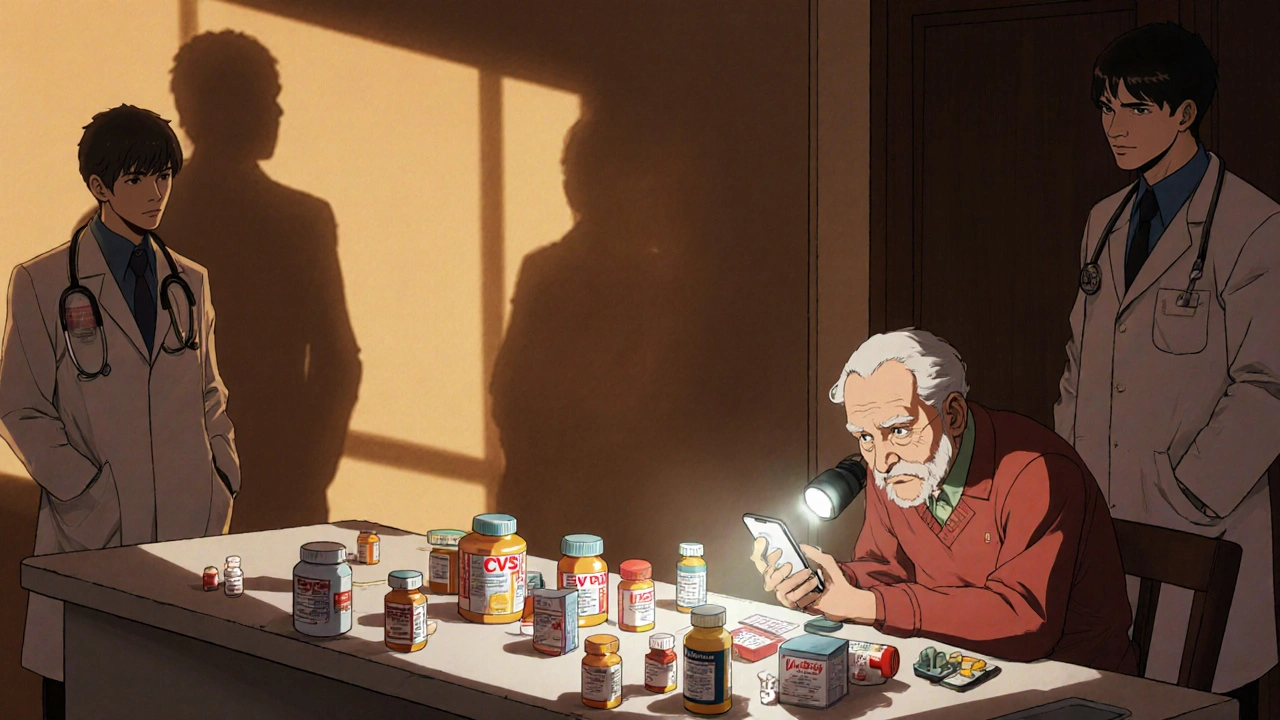
Use One Pharmacy
This is one of the simplest, most effective steps you can take. If you use the same pharmacy for all your prescriptions, the pharmacist has a complete record. They’re trained to spot duplicates. They run checks automatically. If you get a new prescription from a specialist, the pharmacist will compare it to everything else you’re taking.Pharmacists caught 42% of duplicate medication errors in a 2022 survey by the American Society of Health-System Pharmacists. But only if they had the full picture. If you switch pharmacies every time, you’re removing that safety net.
Ask the Right Questions
When a specialist writes you a new prescription, don’t just take it. Ask:- “Is this medicine replacing something I’m already taking?”
- “What’s the reason for this new drug?”
- “Could this interact with anything else I’m on?”
- “Can we review all my meds together?”
Use the teach-back method: After your doctor explains, say, “So if I understand right, this new pill is for my heart rhythm, and it’s not replacing the one my PCP gave me for blood pressure?” Then repeat it back. If they hesitate, dig deeper.
Don’t be afraid to say, “I think I might already be taking something like this.” Many patients don’t speak up because they don’t want to challenge their doctor. But you’re not challenging-you’re collaborating. And you’re the only one who knows your full history.
Get a Medication Reconciliation
Medication reconciliation isn’t a buzzword-it’s a safety protocol. It’s when a healthcare provider compares your current list of meds with what’s being ordered. The Joint Commission requires it at every transition of care: hospital discharge, specialist visit, even a clinic appointment.But it only works if you bring your list. Don’t assume your doctor looked it up in the system. Electronic records are messy. They often miss OTC meds, supplements, or meds from other providers.
Ask your primary care doctor to do a full medication review at least once a year-or anytime you see a new specialist. Bring your list. Bring your bottles. Say, “I’d like you to check if any of these overlap or could cause problems.”
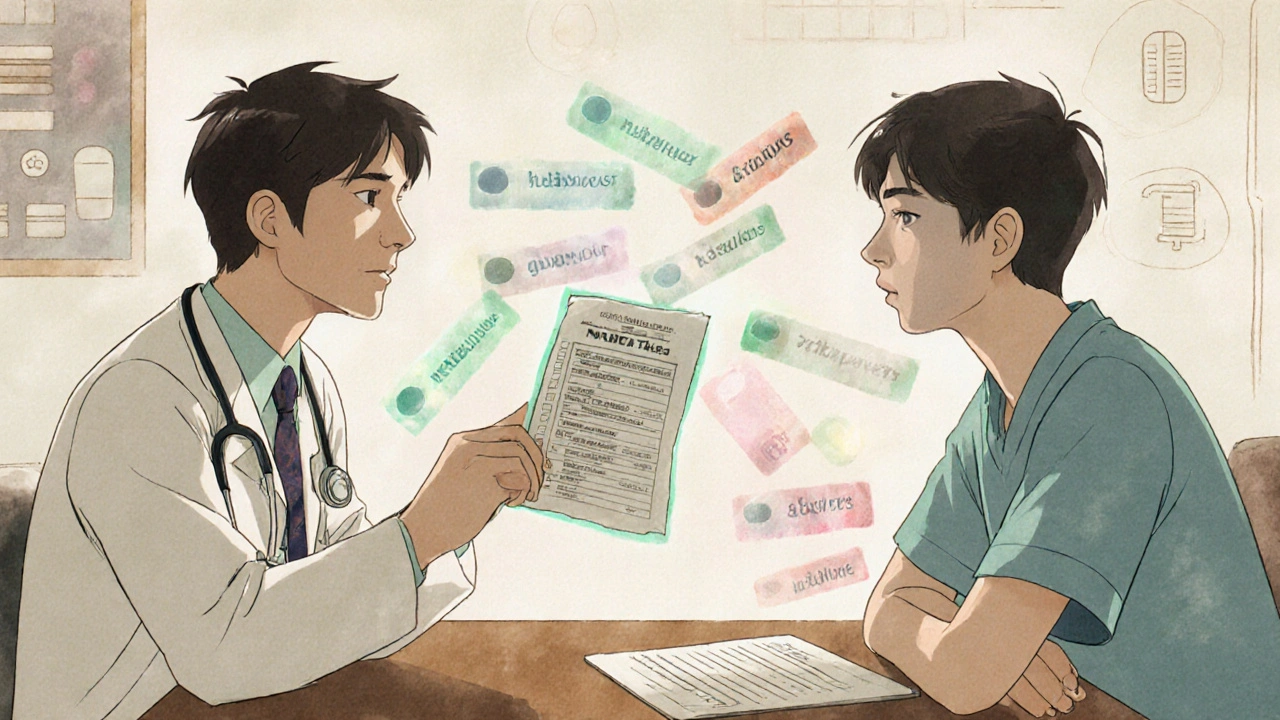
What About AI and Technology?
Some clinics are using AI tools to catch duplicates before they happen. Mayo Clinic’s pilot program boosted detection rates by 143% by analyzing clinical notes and prescription patterns. But these tools aren’t everywhere. And even when they exist, doctors sometimes override alerts because they’re rushed.Technology helps-but it doesn’t replace you. The most reliable system is still a person with a printed list, a pharmacist who knows your history, and a doctor who listens.
Real Consequences
One Reddit user shared how they took metoprolol from their PCP and then got another metoprolol from their cardiologist. They didn’t realize it was the same drug. Their blood pressure dropped so low they passed out at home. Their spouse called 911. They spent two days in the hospital.Another woman took two different NSAIDs for arthritis. She didn’t know both contained the same active ingredient. She ended up with a stomach ulcer and internal bleeding. Her doctor later said, “I didn’t know you were taking the other one.”
These aren’t outliers. They’re examples of what happens when systems fail and patients aren’t armed with information.
Bottom Line
You don’t need to be a medical expert to prevent duplicate medications. You just need to be organized and speak up.- Keep a current, detailed list of every medication and supplement you take.
- Use one pharmacy for all your prescriptions.
- Bring your list-and your pill bottles-to every doctor visit.
- Ask questions. Always.
- Request a medication reconciliation after any specialist visit.
The goal isn’t to take fewer pills. It’s to take the right ones. No more doubles. No more surprises. Just clarity-and safety.
How do I know if I’m taking duplicate medications?
Look at the drug class, not just the name. If you’re taking two drugs from the same class-like two beta-blockers, two statins, or two NSAIDs-you may have a duplicate. Check with your pharmacist or use a free app like Medisafe to scan your pills and flag overlaps. Always ask your doctor: “Is this replacing something else I’m taking?”
Should I stop a medication if I think it’s duplicated?
Never stop a medication on your own. Even if you suspect duplication, contact your primary care doctor or pharmacist first. Stopping suddenly can be dangerous-especially for blood pressure, heart, or mental health meds. Let a professional review your list and decide what to adjust.
Can over-the-counter medicines cause duplicates?
Yes, and they’re a major cause of accidental overdoses. Many cold, sleep, and pain meds contain acetaminophen, ibuprofen, or diphenhydramine. If you’re already taking a prescription with one of those ingredients, adding an OTC version can push you over safe limits. Always check labels and tell your doctor what you’re taking-even if you think it’s “just a vitamin.”
How often should I update my medication list?
Update it every time you start, stop, or change a medication-even if it’s temporary. Also update it before every doctor or pharmacy visit. A list that’s three months old might be outdated and misleading. Keep it digital and physical, and carry the paper copy with you.
What if my doctors don’t communicate with each other?
That’s common. Don’t wait for them to talk. Be the bridge. Bring your updated list to every appointment and say, “Can you please share this with my other doctors?” You can also ask your primary care provider to coordinate your care. Many clinics now offer medication management services-ask if yours does.

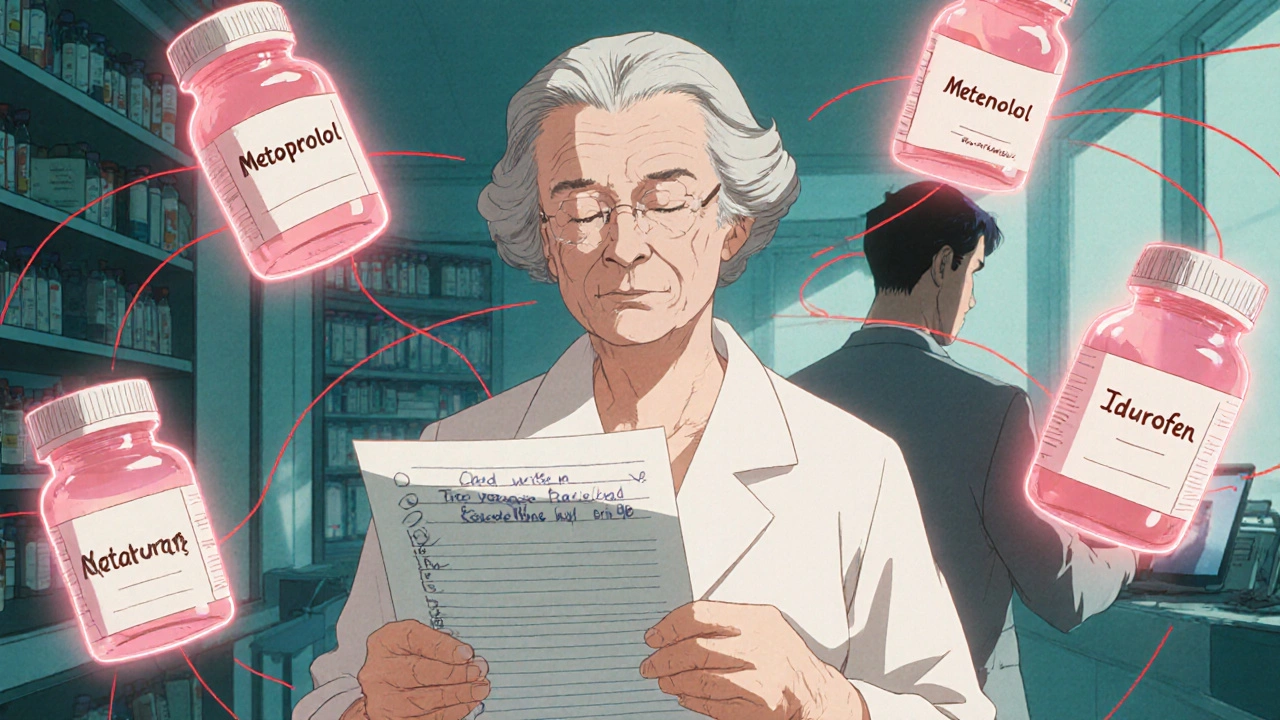
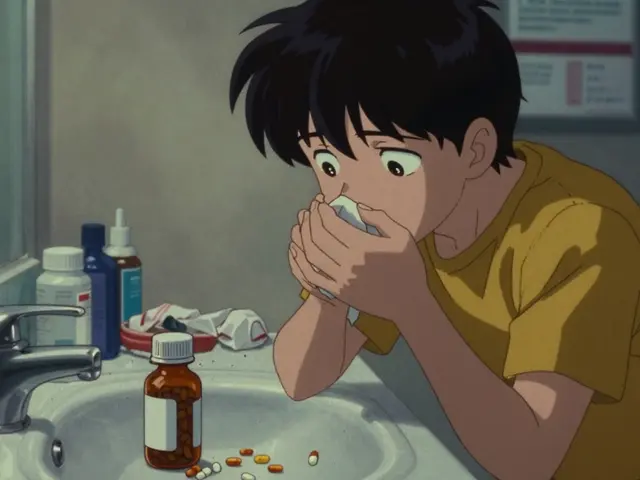
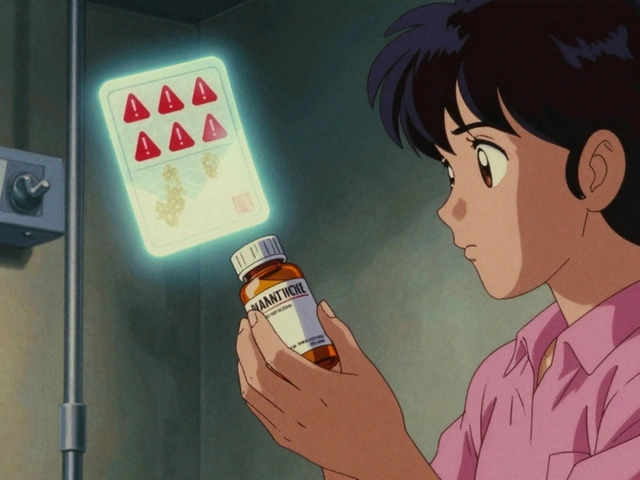
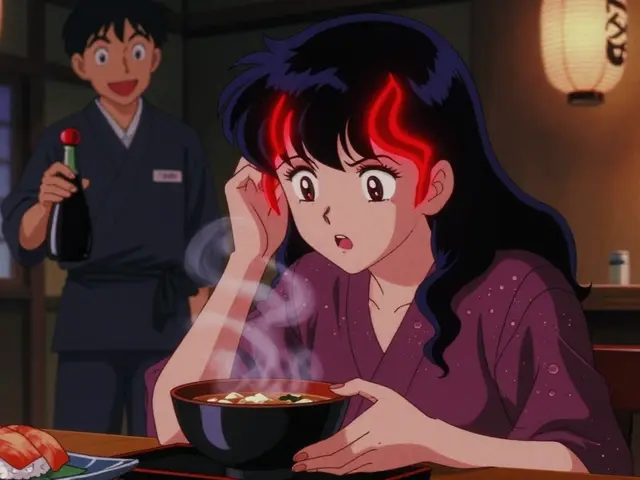
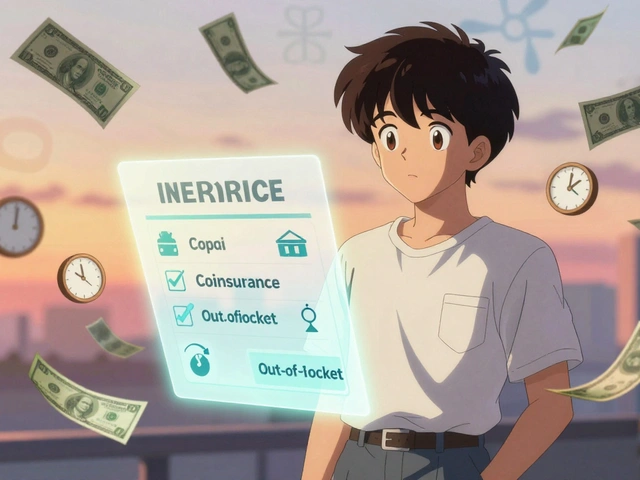
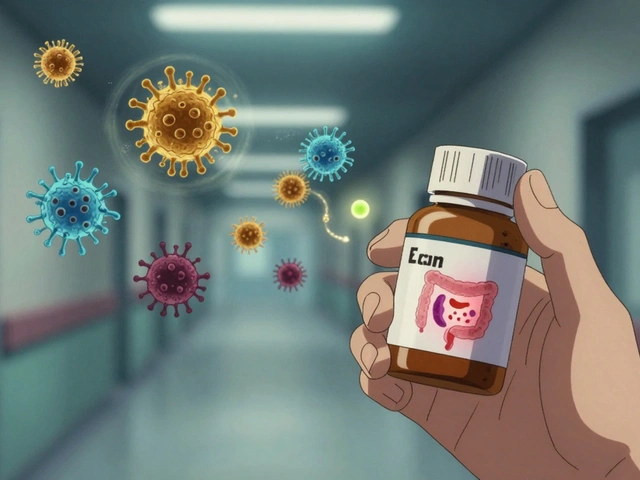
Victoria Short
November 14, 2025 AT 04:48Yikes. I just realized I’ve been taking Tylenol PM and that prescription antihistamine. I’m gonna check my bottles tonight.
Jessica M
November 15, 2025 AT 10:50It is imperative that individuals managing multiple chronic conditions maintain a meticulously updated pharmaceutical inventory. Pharmacists serve as indispensable gatekeepers in the prevention of iatrogenic harm, yet their capacity to intervene is contingent upon comprehensive data disclosure by patients. The adoption of standardized, digitized medication reconciliation protocols at every clinical transition is not merely advisable-it is a non-negotiable standard of care.
sara styles
November 16, 2025 AT 06:45Let me tell you something they don’t want you to know-pharmaceutical companies and Big Pharma doctors are INVESTED in keeping you on multiple overlapping drugs. Why? Because it’s a billion-dollar racket. They don’t want you to know that metoprolol and atenolol are the same class-because if you did, you’d question why you’re paying for two prescriptions. And guess what? Your ‘primary care doctor’ probably doesn’t even have access to your specialist’s notes. The EMR systems are fragmented on purpose. They want you confused. They want you dependent. I’ve seen it. My aunt got prescribed two different PPIs for acid reflux-same effect, double the side effects, triple the profit. And now she’s on a bone density drug because the PPIs ate her calcium. It’s not negligence-it’s design. Wake up. Bring your bottles. Don’t trust the system. Trust your own eyes.
Eric Gregorich
November 16, 2025 AT 20:03You know what’s really sad? It’s not just the meds. It’s the loneliness. People don’t have someone to sit with them while they sort through their pill organizer. I’ve watched my dad go from three prescriptions to twelve in two years, and no one ever sat down with him and asked, ‘Why are we doing this?’ He’s 78. He doesn’t know what ‘beta-blocker’ means. He just takes the pills because the doctor said so. And now he’s dizzy all the time. No one checks. No one cares. The system is built for speed, not safety. We treat medicine like a conveyor belt-pop, pop, pop-and forget that people are still human. I’m not mad at the doctors. I’m mad at the machine. And if you’re reading this, and you’re caring for someone older-take the time. Sit down. Lay out the bottles. Ask the questions. Even if it takes an hour. Because that hour might be the one that saves their life.
Koltin Hammer
November 18, 2025 AT 10:38There’s a quiet kind of wisdom in the simplicity of ‘one pharmacy.’ It’s not just about convenience-it’s about continuity. Like having the same barber who remembers you hate the sides too short, or the same grocer who knows you always buy the organic apples. That relationship matters. The pharmacist isn’t just a person behind the counter-they’re the keeper of your chemical story. And when you switch pharmacies like you switch Netflix accounts, you’re erasing chapters of your own health narrative. I’ve seen it. My neighbor switched to a new pharmacy after her husband passed, and they didn’t catch the duplicate statin until she had muscle pain so bad she couldn’t climb stairs. The new pharmacist said, ‘We didn’t have your history.’ And that’s the tragedy. We’ve outsourced memory to algorithms, but algorithms don’t care if you’re scared, or tired, or confused. People do.
Phil Best
November 18, 2025 AT 22:15Oh, so now we’re blaming patients for the healthcare system’s incompetence? Brilliant. Let’s just make the 72-year-old with arthritis, diabetes, and heart failure memorize every drug class like they’re studying for the MCAT. Meanwhile, the specialist who wrote the duplicate script got a $15,000 bonus for hitting their ‘prescription volume’ quota. Funny how that works. You want people to be safe? Fix the incentives. Stop rewarding doctors for writing more scripts and start rewarding them for writing fewer. And for God’s sake, make EMRs talk to each other. It’s 2025. My smart fridge knows I’m out of milk. Why can’t my cardiologist’s system know my PCP prescribed a beta-blocker? It’s not rocket science. It’s corporate greed wrapped in a white coat.
Parv Trivedi
November 19, 2025 AT 10:41This is very important. In my country, many elderly take many medicines because they are afraid to stop. They think if they stop one, their body will collapse. But they do not know that some medicines are same. I suggest that everyone should make a list, even if it is on paper. And if they are not sure, they should ask their pharmacist. Pharmacist is not just person who gives medicine, he is friend who protect you. Also, do not be afraid to ask doctor again. Doctor is human too. They forget. We all forget. But your health is not something to forget.
Willie Randle
November 21, 2025 AT 10:05For those who feel overwhelmed: start small. Pick one medication you’re unsure about. Look up its generic name on Drugs.com. Compare it to your other pills. Write it down. Do this once a week. You don’t need to master pharmacology-you just need to be curious. And if you’re helping someone else, make it a ritual. Every Sunday morning, sit with them, coffee in hand, and go through the pillbox. Ask, ‘What’s this one for?’ You’d be surprised how often they don’t know. And that’s not their fault. It’s the system’s failure. But you? You can be the bridge.
Connor Moizer
November 23, 2025 AT 05:58I used to think this was just ‘old people stuff.’ Then my mom got prescribed a new painkiller after her hip surgery. She didn’t tell me she was already taking ibuprofen three times a day. Two weeks later, she’s in the ER with a bleeding ulcer. The doctor said, ‘You didn’t mention the OTC stuff.’ I felt like an idiot. But here’s the thing-I didn’t know to ask. So now? I make a spreadsheet. I update it after every appointment. I screenshot every pill bottle. I don’t care if it’s ‘just’ melatonin. I put it in. Because if I don’t, who will? You’re not being paranoid. You’re being prepared. And in this system? That’s the only thing that keeps you alive.
kanishetti anusha
November 25, 2025 AT 02:57I am a nurse in India, and I see this every day. Grandmothers take five medicines for one problem because each doctor gives one. They think more medicine = better healing. But I tell them: ‘One right medicine is better than five wrong ones.’ I teach them to write names on sticky notes and stick them on the fridge. Simple. No app needed. And I tell them: ‘Ask the pharmacist. He will tell you if two are same.’ They listen because I am kind. And they live longer. You don’t need technology. You need someone who cares enough to sit with you.
roy bradfield
November 25, 2025 AT 07:39This is all part of the Great Pharmaceutical Agenda. They want you dependent. They want you confused. They pay doctors to prescribe duplicates. They pay for EMR systems that don’t talk to each other. They want you to believe that your pills are safe. But look at the data-20.4 alerts per 100 scripts? That’s not a glitch. That’s a feature. The system is designed to keep you on drugs. They don’t care about your kidneys. They care about your monthly refill. And don’t get me started on the OTC stuff-Tylenol PM? That’s diphenhydramine, the same thing they put in sleep aids for seniors. Combine it with a prescription antihistamine? You’re not just sleepy-you’re sedated into oblivion. And when you fall? They call it ‘age-related.’ No. It’s drug-induced. And they profit from your fall. Your hospital bill. Your rehab. Your new wheelchair. It’s all part of the cycle. Wake up. Your pills are not medicine. They’re a trap.
Patrick Merk
November 25, 2025 AT 10:53I love how this post doesn’t just list the problem-it gives you the tools. It’s like someone handed you a flashlight in a dark room full of tripwires. One pharmacy? Check. Updated list? Check. Asking the right questions? That’s the golden ticket. I’ve had my own ‘oh crap’ moment when I realized I was on two different NSAIDs. My pharmacist caught it. She didn’t yell. She just said, ‘You’re lucky you didn’t bleed out.’ And then she made me a little card with all my meds on it. Now I carry it in my wallet. It’s not fancy. But it’s mine. And that’s the point-you don’t need a perfect system. You just need to be the one who shows up.
Liam Dunne
November 26, 2025 AT 08:53My dad used to say, ‘If you don’t know what it’s for, don’t take it.’ He was a mechanic, not a doctor. But he knew engines. And he knew that putting the wrong oil in a car could destroy it. Same with pills. You don’t need to be a chemist. You just need to be a good listener. Bring your bottles. Say, ‘I don’t understand this one.’ Ask, ‘Is this replacing something?’ And if they look at you like you’re stupid? That’s your cue to find a new doctor. Your health isn’t a suggestion. It’s your responsibility. And you’re the only one who can own it.
Vera Wayne
November 26, 2025 AT 21:47I just started using Medisafe-and I can’t believe I didn’t do this sooner. It scans the barcode on the bottle, tells me what each pill does, and flags duplicates. It even reminds me when I’m due for a refill. I didn’t realize I was taking two different statins until it popped up a red alert. I called my doctor immediately. He said, ‘Oh, I didn’t know your cardiologist prescribed one too.’ He changed it right away. It’s not magic. It’s just… organization. And maybe a little tech. But hey-if your phone can remind you to water your plants, it can remind you not to overdose on your own meds. Take the app. Take the list. Take control.
Rebekah Kryger
November 27, 2025 AT 20:20Let’s be real-this whole ‘one pharmacy’ thing is a myth. My insurance won’t cover my meds at one place. I have to split them between CVS, Walgreens, and the VA pharmacy. And my VA meds aren’t even in the same system. So now I’m the human database. I keep a binder. Color-coded. Tabs. Tabs, people. I’ve got a tab for ‘blood pressure,’ one for ‘pain,’ one for ‘supplements,’ and one for ‘what the hell is this?’ I’m not a pharmacist. I’m a chaos coordinator. And if you think this is easy? You’ve never tried to explain to a 70-year-old that ‘atorvastatin’ and ‘simvastatin’ are both statins. They just see two different names and think they’re different. It’s not ignorance. It’s design. And I’m tired.
Erika Lukacs
November 29, 2025 AT 12:09There is a certain poetry in the fragility of the human body when it is subjected to the fragmentation of modern medicine. Each specialist, a priest of a particular organ, offers a sacrament of pills-unaware that the altar is shared, that the offering is duplicated, that the ritual, though well-intentioned, becomes a sacrifice. We are not machines to be tuned, but organisms woven from memory, habit, and fear. The list we keep is not merely a ledger-it is a testament to our vulnerability. And perhaps, in the act of writing it down, we reclaim a sliver of agency from the labyrinth of systems designed to forget us.
Willie Randle
November 30, 2025 AT 02:21To everyone who’s been overwhelmed by this: you’re not alone. And you’re not failing. The system is broken. But you’re doing the hard thing-paying attention. Keep going. One pill at a time. One question at a time. One pharmacy visit at a time. You’re not just managing meds. You’re protecting your life. And that’s worth every extra minute.